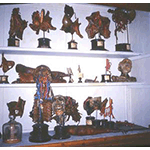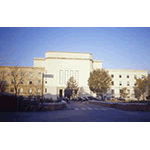Museo Anatomico dell'Universitą degli Studi di Firenze [University of Florence Anatomical Museum]
The origin of the collections in the University of Florence Anatomical Museum dates back to the Physiological Cabinet, opened in 1869 and annexed to the Hospital of Santa Maria Nuova. In 1936 the Cabinet was moved to its present site, in the hospital complex of Careggi. Today the Museum is managed by the Department of Anatomy, Histology and Forensic Medicine, established in 1999 under its present name.
The museum's collections are divided into four sections: the osteological collection, the anatomical organic preparations, the waxworks section and the anatomical instrumentarium section. The objects in the osteological collection, dating from the late 19th and early 20th centuries, are displayed in fourteen showcases and described in a handwritten catalogue. In addition, there are fully assembled skeletons dating from the end of the 18th century. The collection of anatomical specimens, enlarged over the course of time, comes from the Physiological Museum of the Royal Institute of Higher Studies. Of special interest is the series of specimens prepared by Filippo Pacini, Paolo Mascagni and Luigi Paganucci. One section is dedicated to the "petrified" objects of Girolamo Segato. The waxworks collection contains anatomical wax figures and plaster casts. Noteworthy is the original wax model of the corpuscles sensitive to touch, called "tactile ganglions", commissioned by their discoverer Filippo Pacini in 1863 of Remigio Rei, the wax modeller of the Specola school. In the anatomical instruments section are drawers containing instruments used for surgery and dissection. Some of the objects in the Museum are still used today in the Department's teaching activity.
The Department's library possesses a notable heritage of ancient books, including rare sixteenth-century editions, precious editions from the 17th century, the catalogue compiled by Pacini near the middle of the 19th century, and another anonymous catalogue from the 20th century.
****************************
Texts by Francesca Carletti
English translation by Catherine Frost
Last update 31/gen/2008





